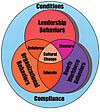
Shaping a new safety culture: Include all behavioral aspects (Organizational, Leadership, Hourly Workforce); utilize education, measurement and positive reinforcement; address physical conditions and understand compliance issues.
In order to improve your workplace safety culture, follow these eight steps and you’ll be on the road to positive change.
1 Know the “now†safety culture
A thorough understanding of the existing culture must be accomplished. This can be realized by canvassing a large sampling of the total workforce to measure what perceptions, practices and conditions related to safety currently exist. A cultural survey can surface what is working and what is not. The information obtained can provide direction for change.2 Secure management/supervision commitment
Without the commitment of leadership no change can be effected. Leadership and organizational behaviors are key to the success of any process…setting the example to follow. Workers’ behaviors often mirror those of management and supervision. Once employees see management and supervision “walk the talk†they’ll begin to trust and accept that the change is genuine.3 Determine, agree on and communicate parameters
The biggest element in safety culture is the behavioral element. All parties must agree to look at practices (behaviors) and determine those best suited to working safely. Workplace conditions and compliance/disciplinary processes must also be evaluated. Communication systems and levels of involvement by all workers need to be included in determining the safety culture change components. All employees should be involved in drawing up the picture of the desired safety culture.4 Develop a plan for change and ongoing process
Once the parameters of change are identified, a roadmap must be developed. This involves determining training methods and schedules, measurement processes and means of communication, and defining and assigning responsibilities and accountabilities. Lead and working sub-teams must be formed.5 Educate
Training is an important step in the process of changing behaviors. Leadership behaviors have been identified as key to developing a new safety culture. Therefore, supervisors play a very important role in this effort. Employees are often promoted to supervisory positions based on job skill with little or no training in leading people. The supervisor is the direct link between management and primary employees, therefore supervisors must be given the training and tools needed to deal with satisfying the needs of both management and the primary workforce, which are often in conflict.6 Measure
What gets measured gets done. Once a measurement process has been decided on (with a behavioral-based process this involves daily observations and analysis), it is important to utilize and communicate the information gathered. If data is collected and nothing is done with it, it becomes worthless. In developing the measurement process, solicit input from the entire workforce in identifying the best safe practices and conditions to be measured. Don’t underestimate the knowledge of hourly employees.7 Reinforce & communicate
People do more of what brings good consequences. Positive reinforcement is an important element missing from many workforce cultures. Statistics show that when workers are positively reinforced they will go beyond what is expected of them.A strong communication system between all employees in all directions needs to be encouraged.
8 Develop informal leaders and a sense of community
Informal leaders in the workforce are usually well recognized. They play an important role in the success of any change, and their buy-in can be critical. Champions often surface in the planning and training stages. These champions should be nurtured and encouraged to become informal leaders and decision-makers.A sense of community will build as trust is developed and people begin to learn more than just their job responsibilities.

